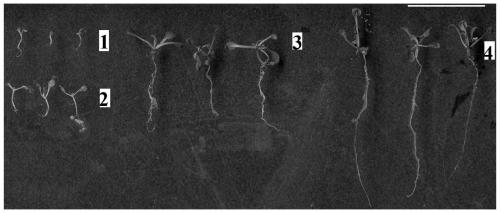Key gene TcSBP5 regulating salt tolerance of tamarix chinensis and application of key gene TcSBP5
A key gene, salt tolerance technology, applied in application, genetic engineering, plant genetic improvement, etc., to achieve the effect of reducing the germination rate of salt tolerance
- Summary
- Abstract
- Description
- Claims
- Application Information
AI Technical Summary
Problems solved by technology
Method used
Image
Examples
Embodiment 1
[0021] Embodiment 1: clone TcSBP5 gene by RACE technology
[0022] Based on the TcSBP5 sequence of Tamarix RNA-seq data, 5′ and 3′ RACE primers were designed, two specific products were amplified by nested PCR, sequenced by T-vector cloning, and the sequencing results were spliced by overlapping regions to obtain the full length of cNDA .
[0023] details as follows:
[0024] I. Primer Design
[0025] The 3'RACE forward primer is:
[0026] Outer Primer F:
[0027] Inner Primer F:
[0028] The 3'RACE reverse primer is:
[0029] Outer Primer R:
[0030]
[0031] Inner Primer R:
[0032] The 5′RACE forward primer is
[0033] Outer Primer F:
[0034]
[0035] Inner Primer F:
[0036] The 5′RACE reverse primer is:
[0037] Outer Primer R:
[0038] Inner Primer R:
[0039] II.3'RACE reaction process:
[0040] (1) For reverse transcription, add the following components to an RNase-free centrifuge tube placed on ice: 1 μg Total RNA (the plant material...
Embodiment 2
[0074] Embodiment 2: TcSBP5 gene plant expression vector construction
[0075] The overexpression vector of TcSBP5 gene was constructed by pathway cloning technology. Using specific PCR primers (TcSBP5 ORF primers in Example 1), PCR amplification was performed using cDNA as a template, and the TcSBP5 gene ORF was constructed into an entry vector. The entry vector was pCRTM8 / GW / TOPOTM vector (Invitrogen). The reaction system is: Fresh PCR product (purified) 10-20ng; Salt solution 1μL; pCRTM8 / GW / TOPOTM vector 1μL; add sterile ddH2O to make up 6μL. The reaction procedure is: stand at room temperature for 30 minutes.
[0076] Pick positive clones from the screening culture plate for sequencing verification, and perform LR reaction with the positive entry vector and the plant expression vector PBI121GW. Vector plasmid such as figure 1shown. The reaction system is: entry vector 100ng; PBI121GW vector (100ng / μL) 1.5μL; LR Clonase II enzyme mix 2μL; add TE (pH 8.0) to make up 10μ...
Embodiment 3
[0077] Example 3: Genetic transformation of the TcSBP5 gene
[0078] The constructed PBI121GW-TcSBP5 overexpression vector was transformed into Agrobacterium strain EHA105 by liquid nitrogen freeze-thaw method, and the TcSBP5 gene was transformed into Arabidopsis by Agrobacterium tidbits infection method. The obtained positive Arabidopsis seeds were tested for germination rate and plant phenotype observation on MS solid medium containing 0.3% NaCl (51 mM). figure 2 PCR detection of TcSBP5 insert fragments for 10 successfully transformed transgenic Arabidopsis; image 3 This is the overall morphology comparison between the transgenic Arabidopsis overexpressing TcSBP5 and the wild type. The growth substrate is MS solid medium containing 0.3% NaCl (51mM). After 14 days of growth in Arabidopsis 0.3% NaCl medium, it was transferred to NaCl-free MS medium for desalination treatment for 14 days, 3 was wild-type Arabidopsis 0.3% NaCl medium for 28 days, and 4 was wild-type Arabidops...
PUM
 Login to View More
Login to View More Abstract
Description
Claims
Application Information
 Login to View More
Login to View More - R&D
- Intellectual Property
- Life Sciences
- Materials
- Tech Scout
- Unparalleled Data Quality
- Higher Quality Content
- 60% Fewer Hallucinations
Browse by: Latest US Patents, China's latest patents, Technical Efficacy Thesaurus, Application Domain, Technology Topic, Popular Technical Reports.
© 2025 PatSnap. All rights reserved.Legal|Privacy policy|Modern Slavery Act Transparency Statement|Sitemap|About US| Contact US: help@patsnap.com



